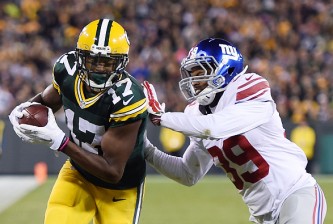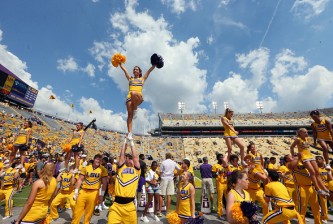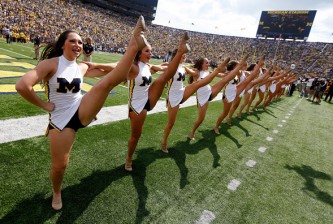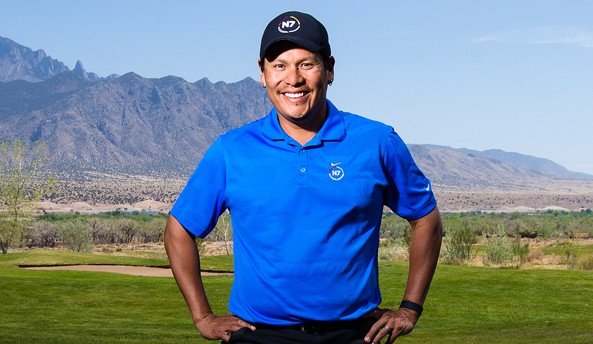We continue our guest columns. Tim Dobyns of Minneapolis, MN profiles Golf Channel on-course reporter Notah Begay III who just recently returned to the network after suffering a heart attack.
Last week, Notah Begay III returned to his analyst role on the Golf Channel, serving as the on-course reporter for the NCAA Championships just a month after suffering a heart attack. Behind the mic, we’ve watched Begay grow since his January 2013 debut at the Sony Open, exchanging bit by bit his initial deer-in-the-headlights reluctance for a reserved but confident package of keen insights and candid criticism—a craft spoken with the tart precision of a man who has experienced firsthand the vagaries of success and failure on the meritocratic PGA Tour. Though often criticized for exhibiting too little emotion, the earring-adorned Begay continues to fill the airwaves with his soothing monotone, evoking a phonetic graph more closely resembling Siri than Gus Johnson. He avoids the humorous theatrics of David Feherty, the I-used-to-be-better-than-all-these-guys air of Johnny Miller, and the corporate-epic loom of Jim Nantz. In that respect, he is old-school golf commentating—razor-sharp insights delivered with a sometimes Morphean tone. He’ll continue to grow as a commentator as he becomes more seasoned, developing increased tonal variance while maintaining pinpoint analysis.
Finding a definition for Notah Begay’s role in golf, his lasting legacy, is always going to be difficult. He is the only full-blooded American Indian—a Navajo—to play on tour. Once the second-ranked junior golfer in the country, Begay earned a scholarship to Stanford University where he helped the Cardinal to the 1994 NCAA Championship, thanks in part to his blistering Stonebridge Country Club with a still-active NCAA Tournament record 62. And yes, that NCAA Championship marked Begay’s last year at the school in which Tiger Woods was still unenrolled. As a professional, Begay won four tournaments in 1999 and 2000, reaching the top 20 in the World Golf Rankings before finding his career derailed by the cruelest paramour of the declining golfer: back problems.
Since then, his real-world philanthropic accomplishments seem to live under a perpetual awning, eclipsed by the towering shadow of Woods, his college roommate, great friend, and fame foil. Though Begay says he’s proud of his connection to Stanford and his friendship with Woods, the media consistently qualifies any story on Begay with unrelated news on Woods. Here’s one: USA Today’s Erik Brady recently wrote a story on Begay’s criticism of Daniel Snyder and the continued use of the word “Redskins.” Brady also mentions Begay’s degree in economics from Stanford, as well as the philanthropic venture he founded, the Notah Begay III Foundation (NB3F), which seeks to fight and prevent type 2 diabetes and childhood obesity in young American Indians. After completing the great story, Brady (or his editor) decides that a little bit of topical necromancy was in order, summoning this following bit of irrelevancy in the final paragraph:
Begay says he speaks often with former Stanford teammate Tiger Woods, who is rehabilitating from back surgery. “It’s going very well,” Begay says. “His pain has been eliminated. He just has to continue to take it easy for a few more weeks and that’s probably the hardest thing for him to do right now.”
Then the story ends. Go read stories on Begay online and you’ll find that this is the norm, not the exception. Begay, the grandson of a World War II “Windtalker,” grew up in the San Felipe Pueblo near Albuquerque, witnessing firsthand the destitution and hopelessness afflicting many American Indians, a group that is the most at-risk minority population in the country for a litany of societal problems. Though a mere .8 percent of the total population, they bear the highest rates in the country of a toxic collection of scourges, including poverty, unemployment, alcoholism, drug addiction, mental health disorders, school drop outs, child mortality, suicide, domestic violence, and teenage pregnancy, adding the lowest life expectancy as the putrefied cherry on top.
Because American Indians are such a small percentage of our population, many of these issues are shrouded in silence—politicians’ time apparently is better spent elsewhere and tribal leaders lack the clout to make waves nationally. Interestingly, the population of full-blood American Indians increased by 39 percent between the 2000 and the 2010 census, giving them the youngest age distribution of any racial group and evincing Begay’s mission to assist in youth development, health and fitness. Though Begay has made millions of dollars as a professional golfer and now TV analyst, his passion for the foundation isn’t gilded guilt. He genuinely wants to make a difference.
NB3F works with tribal communities across the country, giving direct investment grants as a true partner, not as an unseen angel raining largesse from above. The foundation uses an educational model of philanthropy and takes to heart the old aphorism, “Give a man a fish and feed him for a day. Teach a man to fish and feed him for a lifetime.” By the time the various programs are implemented in the reservations, NB3F wants the community to be able to operate them independently without oversight. Though admittedly an idealist, Begay believes that his foundation will effect positive change in the lives of the many American Indian children that it touches. So, in welcoming him back to our television sets, I will continue to hold out hope that the media will begin to see his accomplishments on their own and stop force feeding the Tiger Woods narrative. Begay is more than Woods’ old college roommate, and his legacy of philanthropy toward a population in need deserves to be held in the highest regard.
Tim Dobyns is a sports marketing professional with J Robinson Intensive Camps and a freelance writer in Minneapolis. He is a graduate of the University of Oregon’s Warsaw Sports Marketing MBA program and can be found on Twitter at @timdobyns.
More guest columns will be posted over the next few days.























